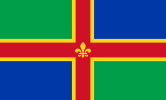Deeping St James Priory

Deeping St. James Priory was a priory in Lincolnshire, England. In 1139 Baldwin Fitz Gilbert established the Benedictine Priory of Saint James at Deeping as a cell of Thorney Abbey.[1] The cell was dissolved at the surrender of Thorney in 1539.[2][3] The priory church remains as the Church of England parish church of Deeping St James and is a Grade I listed building.[4]
The church contained an organ dating from 1902 by Abbot & Smith; a specification can be found on the National Pipe Organ Register.[5]
On the south-east side of the churchyard was the priory tithe barn, which measured 90 feet by 20 feet, 6 inches internally. It has variously been described as 13th century, late 15th century, or 17th century. It was demolished in 1963.[1]
There are no surface indications or remains of the monastic house.[1]
Priors of Deeping

The list of known names is incomplete:[2]
- Jocelyn, occurs in the 12th century
- James Nassington, occurs 1299
- Thomas of Gosberkirk, occurs from 1329 to 1347
- John de Charteris, occurs 1358 and 1365
- William Lee, last prior.
References
- ^ a b c Historic England. "Monument No. 350059". Research records (formerly PastScape). Retrieved 3 August 2011.
- ^ a b "Priory of Deeping". Houses of Benedictine Monks. Victoria County History. Retrieved 3 August 2011.
- ^ Allen, Thomas (1834). The history of the county of Lincoln: from the earliest period to the present time, Volume. Lincoln & London: John Saunders Jr. p. 338. Retrieved 30 April 2013.
- ^ Historic England. "Details from listed building database (1062680)". National Heritage List for England. Retrieved 29 September 2015.
- ^ "NPOR K01089". National Pipe Organ Register. British Institute of Organ Studies. Retrieved 29 September 2015.


